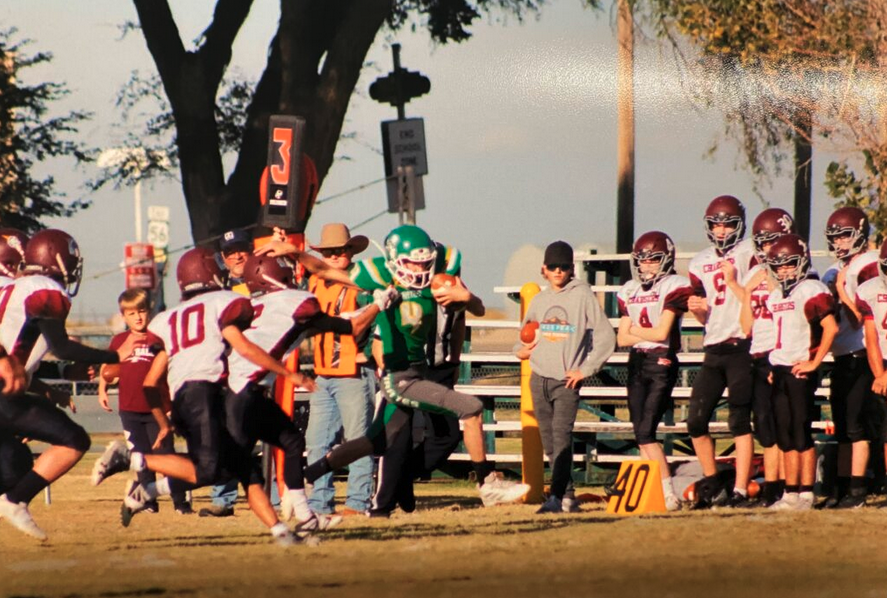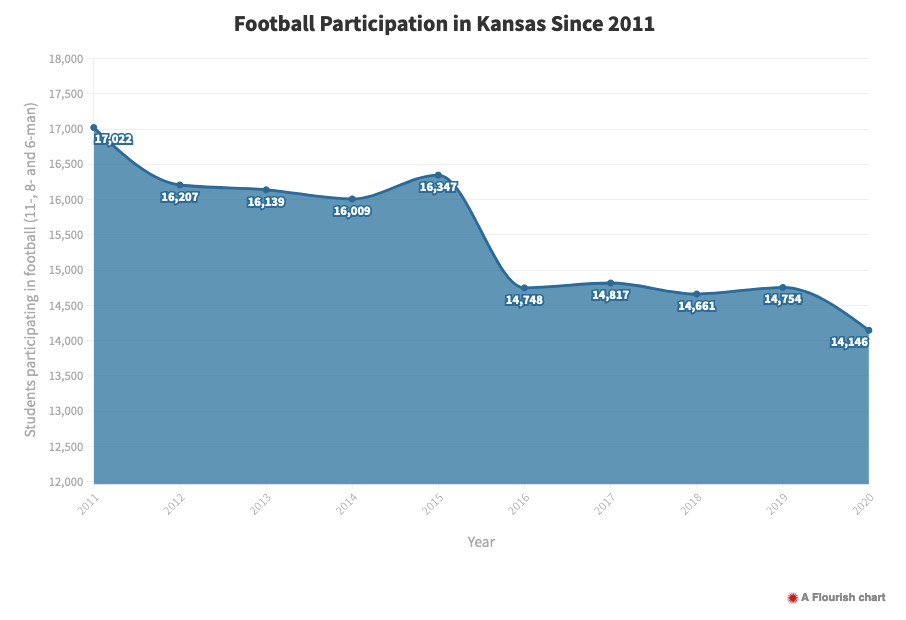
By NOAH TABORDA
Kansas Reflector
TOPEKA — In 2019, Greeley County High School suffered its worst season in years, finishing winless and struggling week in and week out to field a complete team.
At the time, the school was playing eight-man football, but dwindling interest in trying out for football forced a remarkable seven forfeits throughout a nine-game schedule. In the two games they were able to play, they lost 44-0 against Rawlins County and 68-20 against Cheylin.
After conversations about the future of the program, the school made the move to six-man football last year. This year the team finished 2-5, and while the team may not be winning a lot, the players are having fun again.
“At least the kids are getting to play there, right?” said Greeley County High School athletic director Greg Cook. “It keeps interest in fall activities. It allows the kids to still play football and get all the benefits of being part of a team.”
High school football participation has steadily declined over the past decade as concerns around head trauma and other injuries escalate. Add that to the declining population in rural cities and towns, and many schools across Kansas are facing similar challenges to Greeley County.
Six-man football first popped up in Kansas during the 1960s but did not gain widespread traction and eventually disappeared. In 2014, faced with very few options to keep their program afloat, Weskan became the first Kansas team to play six-man since 2003.
Since then, the six-man ranks have risen to 15 schools operating under the Six-man Football Association. The association culminates each year with the Wild West Bowl state championship game in Dodge City.
The participating schools have primarily been in the Northwest and Southwest parts of Kansas. Burrton, in central Kansas, is the furthest eastern school, but that could soon change.
In September, the Kansas State High School Activities Association officially sanctioned six-man football following a unanimous vote of their board of directors. According to the association, 26 teams will play six-man next fall.
Those schools’ total enrollment for ninth, 10th and 11th grade must range from 19 to 55 students, although some in that range have chosen to play eight-man football. In addition to an official schedule and playoffs, Cook said the association’s sanction will help smaller schools like his.
“The schools that are borderline that are hanging on to eight-man — if they should happen to lose some students or have some small classes — it’ll be easier for them to move down to six-man,” he said.
Altoona-Midway, Chase, Chetopa, Ingalls, Southern Coffey County, Centre, Peabody-Burns, Southern Cloud, Tescott, Waverly, Wetmore and Triplains-Brewster will all be part of the newly sanctioned division next year, the state high school athletics association announced. Many of the schools switching to the six-man division hail from the eastern side of the state.
Those teams have a combined 19 wins and 72 losses this fall. Chase and Chetopa took forfeits because of low participation, and Centre was unable to field an eight-man team and played some six-man games.
Peabody-Burns was exploring a six-man move this summer. Only Waverly had a winning record last season.
“The game of football is great for kids, it’s great for communities and it is safer than it’s ever been,” said Mark Lentz, assistant executive director for the state High School Activities Association.
A full high school schedule is nine football games. Last year, six-man squads averaged 6.2 games.

Rule differences
In states like Colorado, Texas and Nebraska, the six-man modifications to the standard 11-man rules have resulted in high-scoring games. This trend has held true in Kansas so far.
The games are heavy on offense and, like eight-man football, can be extremely high scoring, with some games eclipsing 200 combined points scored. Besides the score and shorter field (80 yards vs the normal 100 yards) six-man is unique to both eight-person and 11-person football.
However, the aim of the game is still the same, Lentz said.
“Football is football,” he said. “It just looks a little bit different when you have six players on a side versus 11 but it’s still all about blocking and tackling and the fundamentals that you learn from playing a team sport.”
One noticeable rule change is that to advance the ball forward on a run play, the ball must be exchanged between players at least once. As a result, the running back will oftentimes receive the snap and immediately toss the ball to the quarterback, giving them the choice to either run or pass the ball.
Rather than the typical 10 yards needed for a first down, six-man football requires teams to advance the ball 15 yards.
Scoring is also unique, with extra points worth two when kicked as opposed to one. Field goals are worth more as well — four points earned during a successful kick versus the typical three.
The other big rule change: Everyone on the field is eligible to receive the ball. That includes the center. Though three players must be on the line of scrimmage on many calls the center will be the lone lineman — and the defense will still have to wonder if he’s going out to receive a pass.
“It’s taken me four years to finally figure out some of the little nuances about the game of six-man,” said Jon Schnable, football head coach and athletic director for Rolla High School. “At first, I thought if you have a big-sized team, you can get away with a lot of things, but if you look at the six-man schools, their kids’ size isn’t a priority, it’s speed. If you’ve got some speed on your team, you can win a lot of ballgames.

Dwindling participation
While the number of players and various rules may differ, advocates of the six-man variety will take what they can get, especially when participation numbers continue to drop across the country.
According to data from the Aspen Institute and the National Federation of State High School Associations, from 2008-19 to 2018-19 the total number of youths aged 6 to 18 playing tackle football fell by more than 620,000. Participation nationwide now sits at just over 1 million high school players.
Over that same decade attendance at college and professional football also declined.
However, there is optimism among some that the annual declines in participation appear to be leveling off for now. While COVID-19 made data for 2020 difficult to collect, in 2019 high school football participation only dropped by 2,489 students.
Previous years saw declines of 23,311, 20,540 and 30,829 students playing football.
“These (2019) numbers suggest to us that parents are appreciative of the risk minimization efforts that have been put in place,” said Karissa Niehoff, director of the National Federation of State High School Associations. “Every state has enacted rules that limit the amount of contact before the season and during practice, and every state has established concussion protocols and laws.”
Kansas has also seen the drop in participation level off recently with football participation hovering in the high 14,000-student range since 2016. In 2020, however, the state high school activates association recorded the first notable decrease in participation since that year.
Still, other research shows increasing parental concerns about concussion risks. This raises concerns for future participation across the country and in Kansas.
For example, some have suggested implementing age-based restrictions on physical contact in the sport.
In a 2019 study of the favorability of an age cap, several researchers wrote, “US parents are willing to accept age limits on tackling in youth football.” They added that the organizations responsible for shaping public discourse about the topic, like the American Academy of Pediatrics, “may find it useful to consider US parents’ attitudes regarding age limits on tackling, alongside research quantifying the risk of tackling, when they revisit this topic.”
‘Fighting to keep football’
As the first team to bring six-man football back to Kansas, Weskan has seen it evolve and grow over the years.
Brett Clow, athletic director and head coach of Weskan’s football team, said he expects six-man football’s growth to continue. Like any changes to a sport with deep roots in many communities across the state, six-man football has its doubters who believe only 11-man football to be “real football,” but Clow said with the sport under the pressure it is, six-man is an important alternative.
“When you look at… some of these small towns fighting to keep football, this is now another option,” he said. “If a school is thinking about it, I would only say how great it’s been for us and that it is worth at least giving it a shot.”
Clow also said he was excited to see the influx of new teams after the state association sanctioned the six-man games and hopes there could be as many as 40 such teams in the state one day.
The format, he said, can help schools that haven’t experienced much past success, like Natoma High School, which won the six-man state title this year after not having won a single playoff game for 47 years.
“It’s really cool for teams like that and schools like that to have success for the first time,” Clow said. “I think once people do see it and schools start participating in it, they’ll realize how much fun it is and that the kids really enjoy it.”






